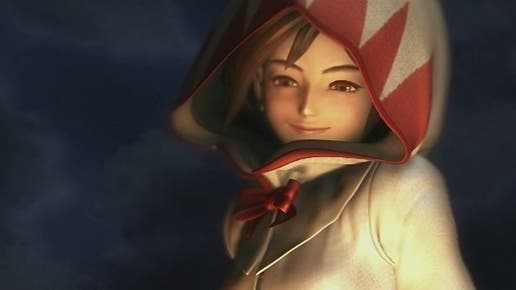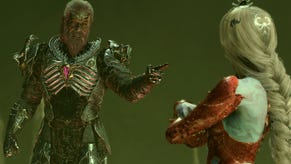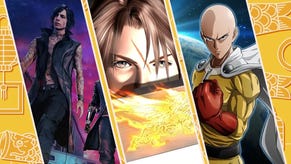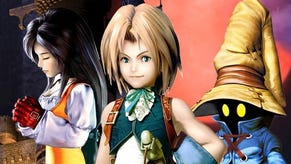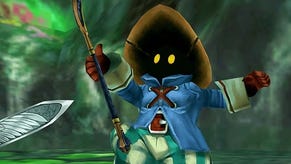Final Fantasy 9 and the picture book adventure of a PS1 Final Fantasy
Fixed-angle Fantasy.
There's a small, almost incidental sequence that I've often thought about since I first played Final Fantasy 9. In it, Princess Garnet (or 'Dagger', at this point in the game) and her buffoonish knight Steiner have a conversation whilst in a hillside cable car, all brass and rivets. Soon after they are reunited with thespian/thief Marcus in the station café, before the next leg of their journey. The area is framed from up high, round tables and stools and bottle green gas-lamps. The lighting is warm, people are chilling, and the music is a near-lullaby recorder version of the game's theme Melodies of Life. The scene feels recognisably suspended, in transit. An enclave of calm and safety removed from normal concerns, like morning light on a weekend lie-in.
Marcus notes that Garnet has changed during her adventures, now more experienced, talking in slang. This is later in another carriage, and you mainly see the back of her seat throughout the conversation, as if happening upon it as it unfolds. Then she gets up, suddenly excited to talk about the things she's seen, the battles she's fought. And then, 'I've always wanted to see the marvellous architecture of Treno! I can hardly wait!'.
'On second thought' - Marcus thinks, in a thought bubble - 'she hasn't changed that much'.
I think what stuck with me was the sense of an in-between time, but captured, noticed. Made visible by its inclusion but still casual, offhand, overheard in the way it's framed on the screen. It's even more effective because the cable car and station sequences straddle more dramatic scenes with hero Zidane and the rest of the gang in the ravaged, rain-pelt kingdom of Burmecia. And I love the sense of scope this brings, that adventures are big (cosmically so, this being Final Fantasy) but they're also asymmetrical and irregular and the small bits matter, too. But also, I love how much of this texture comes from the fixed-perspective backdrops of the game.
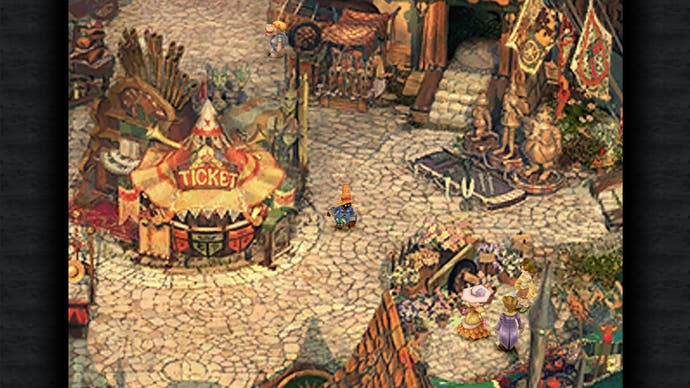
Now you might have guessed, but I only started this replay because I was Full Of Hype from all the Final Fantasy 7 Remake coverage. My YouTube algorithm had doubled-down on reviews and comparisons and Let's Plays. Between you and me, I even got emotional watching a YouTube player herself get emotional at the Remake's title screen and I've barely even played the original. And I never normally watch Let's Plays! I don't even have a PS4!
I had bought 9 for the Switch previously though, not because I had any intention to actually replay my Favourite Ever Final Fantasy - of the four I've played, tied with 12 - but because I vaguely intended to use the new modifiers like No Encounters and Speed-Up to have a dip sometime. A quick-flick through a fondly remembered journey I once took - charming and painterly and medieval-adjacent. I think I'd pegged FF9 as an aesthetic and world I loved (which reminds me of Crystal Chronicles too actually, which is gorgeous), but draped and fastened around a rickety old gameplay machine. I'd bought it as a playable nostalgia prompt, I had no real interest in playing it again properly.
But all that Hype pushed me over - along with those Speed-Up and No Encounters options - and I decided to play a bit, then a bit more, and then a lot. Because to my surprise, the thing holds up! Battle animations have real crunch and flair (and that mid-air hang-time of Freya's Spear!). The menu work is responsive and engrossing, with that bright and breezy chime-squeak noise. Even Zidane's run gait and footstep patter seems somehow right-on and satisfying, with that little whoosh on jumps. And pressing your way through the game's story grammar of dialogue boxes and panto reactions feels less archaic and limited than just different but charming: A uniquely-video game hybrid of reading and theatre, metered out and sped-up with button-presses and without the tedium of voice recordings read out slower (and false-er) than you can read. Oh, and of course there's the music!

But most of all, it's been a treat to play through this kind of adventure again, one that takes place on gorgeous pre-rendered backdrops. Without the concerns of a right camera stick. Without constantly, distractedly roaming my gaze around for the next engagement or interaction. Without being the screen-centred nucleus of all happenings, shifting the world around my avatar's back.
Instead you get the stripped-back, near 2D pleasure of controlling Zidane - or Garnet, who runs knock-kneed, or Steiner who runs like a bucket - around a fixed scene, drawing the control stick around its ring in pleasing curves and loops that follow the path's many (many) meanders. These are routes that curl over and around themselves within a single area - the M6 spaghetti junction but fantasy.
And with this comes characters who run into and out of the scene, sometimes disappearing towards a vanishing point, like on the walkway to Lindblum that stretches away like the bridge in Shadow of the Colossus. Or sometimes startlingly big and screen-filling, the party now all cramped together in Eiko's rock-hewn cave cellar. When Marcus is looking for Blank (who's been petrified in stone by a forest spell) the scene plays out sideways through a silhouette forest like it's Donkey Kong Country Returns.
All this elasticity of perspective lends a neat sort of visual potential energy to the journey, a cinematic framing that's baked into the game as you play it, and a sense of movement and progress as you transfer between backdrops. There's a screen in which you run towards the Iifa Tree on a huge woven road of roots, shot from above with mist-shrouded tendrils stretching far down into the crevasse. Then when you get to the tree proper the camera pans up, the characters dwarfed at the bottom like that famous Secret of Mana title screen.
Yes it is a shame that in these HD ports the backgrounds are a little smeared in translation, and the newly bright and crisp character models look a little detached atop them - you can see a YouTube PSX Let's Play to see how it should look, with the pleasing grain of its unsmoothed textures. And for how good it could look check out the unearthed original source images, or a video of the brilliant-looking AI-enhanced Moguri Mod) - but these images are still a treat. This is a fantasy world that looks lived-in, drawn with a free-hand irregularity. Ladders bend, roof-tiles curve, stairs are uneven, and overall things seem slightly chubby, charming, emplumped (yes, I made that up). But it still feels well-observed and grounded, with that So True recognition of real spaces and how they happen: There's a worn groove in the cobblestones outside a theatre's back-alley entrance. Rat-kid Puck calls to Vivi from a wooden scaffolding platform amidst the rooftops of Alexandria.
Often these areas are anchored by some foreground detail, like the strange dragonfly with a ballooning frog-neck in Black Mage Village, or the clutch of bluebells by the North Gate. And many of the scenes have movement and noise, like the clatter of cogs and gears (there are so many cogs and gears!) or passing clouds outside a shattered airship window. I especially like how the shop and house interiors are painted as if cut-open to peer in, the outside alongside the insides, drainpipes and grass tufts and some birds nesting in the Card Enthusiast's chimney. All of this collapsed together in flatness, squashed into single frames dense with stuff and secret, without being beholden to - and broken by - 3D space and shifting perspectives.
So the story itself plays out as moments witnessed within these scenes, sometimes even across scenes, as FF9's Active Time Event mechanic allows you to cut to character vignettes happening simultaneously elsewhere. And as with any real adventure, important events and conversations often take place in unassuming edge lands and collateral spaces; cellars and riversides and make-shift paths as much as throne rooms and city-squares.
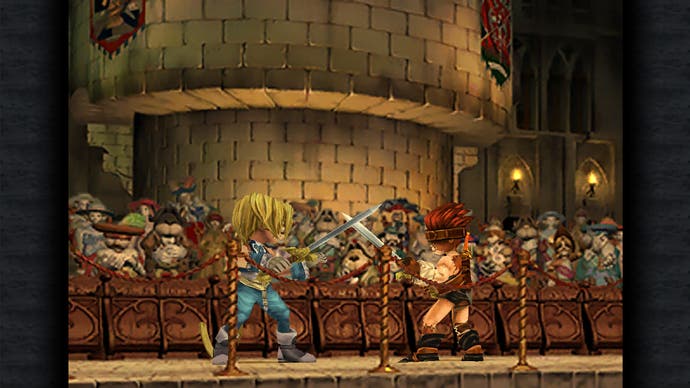
CGI cut-scenes aside, this is drama and movement that occurs within the frame, instead of your avatar being the focus, the centre of the story, The Shit - the heroic, roaming Inducer of Important Moments. Here instead Dagger will run atop the screen, small amidst the clutter of Treno city. Or Eiko the child-summoner will jump off the airship's bow, surprising and sudden without any fuss or angle change. At one point Freya performs a river-dance prayer in the sanctuary of Cleyra, facing the screen like an audience. At the end the camera pans quickly across to see the harpist's strings break into a droplet shiver, which feels interesting and uncertain because it happens within shot, without the machinery of cuts and edits.
Quick aside - have you ever used the word 'continua'? I hadn't! But I recently saw a BBC3 short about languages, and in it this guy just comes on and casually says that language is what 'helps us make sense of the continua of experience'. Just casually! Like 'continua' wasn't the word I'd needed for so long! Because I'm always thinking about this kind of thing. About where you make the breaks, and how that affects the whole.
I often think about the way that music (or silence!) in games is such a physical component of game spaces. And how it can lend that sort of metaphysical differentiation to areas - this place is different to the last in some essential way. And I think a lot about visual voltas too, jolts of change like that fixed shot of the Temple of Time behind Hyrule Square, where suddenly all is quiet and Link seems small. The kind of step change that gives a visual journey its stresses, its passage and rhythm.
Part of the richness of this whole era of Final Fantasy came from its four-course fullness, from flipping between the flavours of battle and town and overworld and menu. But also, from a game made up of pre-rendered or painted screens, its areas tied intractably to their framing, perspective and paths. So that each one is firmed up by specificity, as discreet places in the world and unique beats in the story.
When I'm feeling particularly pretentious (or caffeinated, basically), I wonder if it's a bit like spacetime, and its interdependence. As in, because videogame spaces happen via video (and sound, and play), so how we see and control a character through them also sort of is the space. Like how Samus' weighted movement in Metroid Prime make the planet Tallon IV itself feel heavier, more solid. Or the university newspaper piece I once wrote about playing Tomb Raider Anniversary (The best Tomb Raider. Tied with nothing) with mouse control on PC - able to jump with the right-click and move the camera simultaneously like a first-person shooter - and how it seemed to subtly shift the focus from Lara as a marionette I manoeuvred around the environment, to a central axel around which I looked around tombs. And I can't tell you how much time I spent fiddling about and experimenting in Breath of the Wild - forcing myself to play only with the lock-on camera, or with other Zelda area music playing concurrently through headphones - to try and work out what exactly had so changed the felt quality of this 3D Zelda.
And I wonder how different the spaces of the Final Fantasy 7 Remake feel to those playing fresh, compared to those to whom these new 3D-spaces exist in relation to their memory of the f9ed-perspective 2D originals, like visual DNA now brought to life.
(With caffeine and sugar I'm even worse).
These FF9 backgrounds don't really feel like potential 3D spaces to me, to be imagined and triangulated out into something else - not unless I try to imagine it for fun. Instead it's an adventure that feels- as artist Toshiyuki Itahana says in the Inside Final Fantasy 9 documentary - like a picture book. Occurring in solid, particular visual moments that feel lived in, witnessed, specific. And it's still so fun! With its own type of happening that emerges from these scenes with the luminous, captured happenstance of a photo: The opening with Puck the rat, criss-crossing across Alexandria's rooftops. The chat between Zidane and Vivi by a village wall behind a windmill field. And a long-remembered scene in a hillside cable car, just to the side of the plot proper, but right at the centre of a story that builds and builds from moments and details and asides. And then an ending so lovely I cried.
